Latest Images
M64 Galaxy - Coma Berenices, May 7, 2018
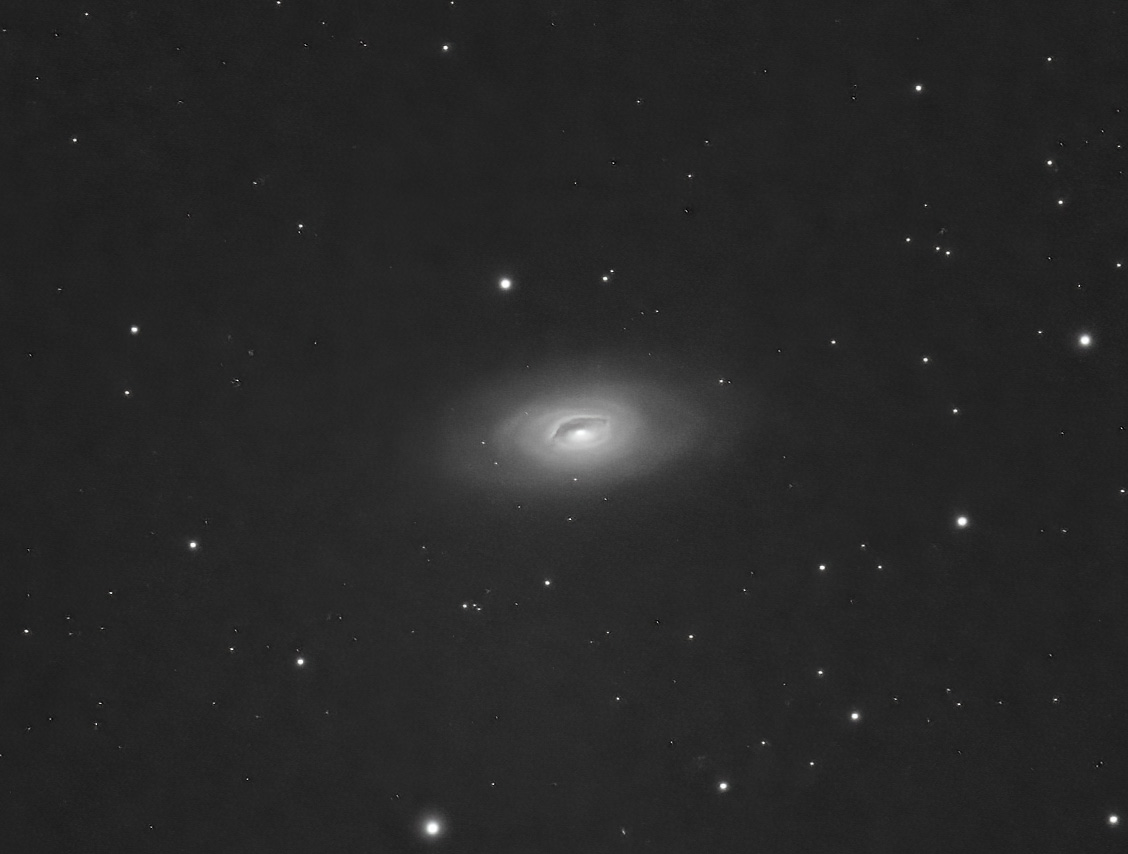
Here is another case of mining old data from 2018 and reprocessing it with the
latest PixInsight and tools in 2024.
This data was taken with my first ASI camera and I was never happy with the outcome
so I never published my results.
The real key to a better image from this data was BlurXterminator which gave
much better details in the galaxy and Topaz DeNoise AI which eliminated the terrible noise.
This image is zoomed in much more than usual for me.
Details:
Location: Front yard Cary, NC
Camera: ASI1600mm-Pro
Exposure: 17 x 1 min exposures gain 139
Filter: UV/IR
Scope: TeleVue Genesis 4" f/5 refractor
Mount: Losmandy G-11
Guider: Orion 60mm finder/guider
Capture software: Maxim DL 5
Guiding software: PHD
Calibration frames: darks, flats, flat-dark
Processing software: Pixinsight, Photoshop CC, BlurXterminator, and Topaz Denoise AI
Weather conditions: Not noted.
Notes:
Back to Mark's Astrophotography Home
Comet 12P Pons-Brooks - Aires, Mar. 28, 2024
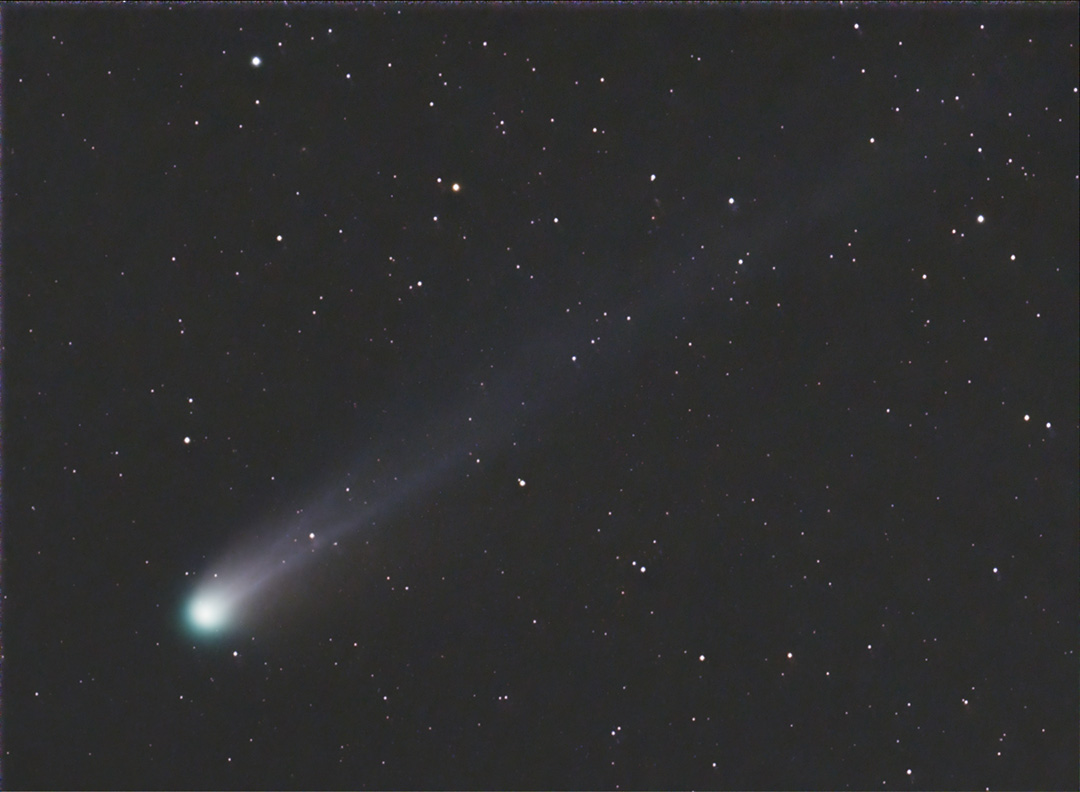
Along with Phyllis and Dave Philipowski, I headed out to the dam at Lake Crabtree in Cary to photograph Comet 12P.
Photographing this comet was a challenge due to the low altitude (around 15 degrees),
evening twilight, many satellites, and very humid conditions due to rain over the last 24 hours.
I was also challenged by an unexpected sortware update to ASIAir, unable to see Polaris to polar align,
the guider not calibrating and poor flats.
I ended up using the first 10 of 45 second shots when the comet was the highest in the sky
and comet aligning those frames with PixInsight.
I used BlurXterminator to round up the stars, and GradientXterminator to get rid of the twilight gradient.
Click on the image for a larger view in a new window.
Details:
Location: Lake Crabtree Cary, NC
Camera: ASI294mc-Pro
Exposure: 10 x 45 second exposures gain 150
Filter: UV/IR
Scope: WO RedCat 61
Mount: iOptron GEM-45
Guider: WO 32mm Uniguide
Capture software: ASIAir
Guiding software: none
Calibration frames: darks, flats, flat-dark
Processing software: Pixinsight, Photoshop CC, BlurXterminator, GradiditneXterminator, and Topaz Denoise AI
Weather conditions: Not noted.
Notes: This image is cropped to around 1 by 2 degrees. North is to the right.
Back to Mark's Astrophotography Home
The Eyes and M86 in Markarian's Chain - Virgo, May 9, 2018

This is a monochrome image of a portion of Markarian's Chain of galaxies which
contains "The Eyes" and M86. North is to the top right of this image.
At the bottom right is the huge elliptical galaxy M86.
To its upper right is spiral galaxy NGC4402.
The Eyes are at the upper left with the larger NGC4438 furthest left.
Above NGC4438 and slightly right is NGC4435.
A much fainter galaxy, IC 3365, is between NGC4402 and NGC4435.
The five galaxies just mentioned range from magnitude 8.9 to almost 15.
Numerious other small faint galaxies are visible.
New advances in PixInsight most notably BlurXterminator made it
possible to go back and rework this old data which was never published due to poor focus.
It turned a poor photo into a good one!
Click on the image for a larger view in a new window.
Details:
Location: Front yard Cary, NC
Camera: ASI1600mm-Pro
Exposure: 30 x 2min exposures gain 139
Filter: UV/IR
Scope: Celestron Edge HD 800 at f/7
Mount: iOptron GEM-45
Guider: Orion 60mm finder/guider
Capture software: Maxim DL 5
Guiding software: PHD
Calibration frames: darks, flats, flat-dark
Processing software: Pixinsight, Photoshop CC, BlurXterminator, and Topaz Denoise AI
Weather conditions: Not noted.
Notes: This image is slightly cropped. I did not get the framing exactly like I wanted it.
Back to Mark's Astrophotography Home
Comet 144P/Kushida in the Hyades, Feb. 5, 2024
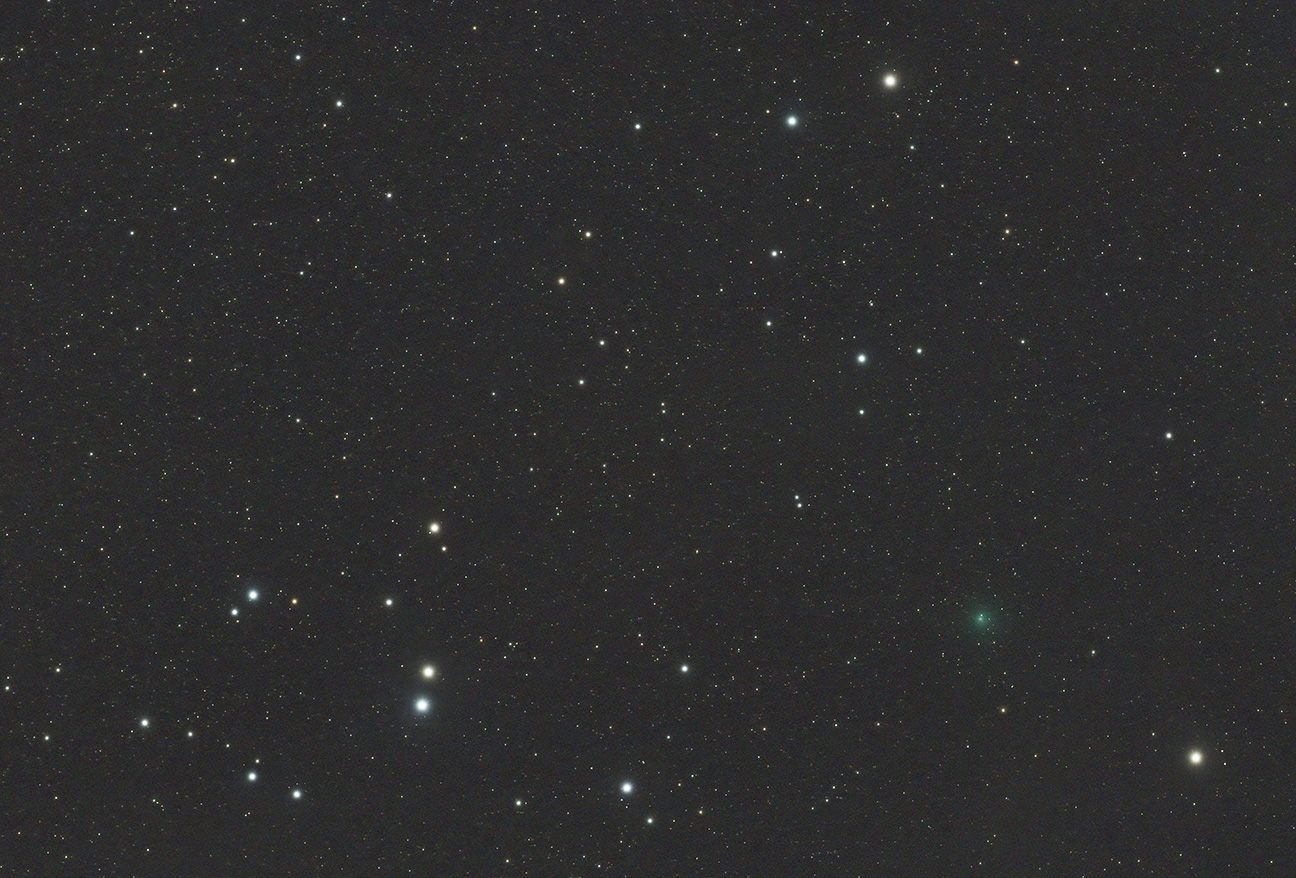
Comet Kushida (small green object at lower right) was passing through the Hyades open cluster
in Taurus the week of Feb. 5, 2024.
The comet was moving pretty fast. Motion was noted between each exposure.
I was hoping to get the entire Hyades cluster, but the field was not quite wide enough.
Aldebaran is just off the FOV to the left side.
This was second light using our new William Optics RedCat 61.
Click on the image for a larger view in a new window.
Details:
Location: Front yard Cary, NC
Camera: ASI294mc-Pro
Exposure: 30 x 45s exposures gain 150
Filter: UV/IR
Scope: WO RedCat 61 300mm f/5.9 refractor
Mount: iOptron GEM-45
Guider: WO 32mm Uniguide
Capture software: ASIair
Guiding software: ASIair
Calibration frames: darks, flats, flat-dark
Processing software: Pixinsight, Photoshop CC, BlurXterminator, and Topaz Denoise AI
Weather conditions: Cold and breezy.
Notes: This image is very slightly cropped. The photo was made from a combination of 30
comet aligned images and 10 star aligned images.
Back to Mark's Astrophotography Home
NGC663 and friends in Cass, Oct. 12, 2023

Four open clusters in Cassiopeia. The bright open cluster upper center is NGC 663.
At the top is NGC 659. At lower left center is NGC 654.
Finally, the faint darkened open cluster at lower right is IC 166.
IC 166 reminds me of the small open cluster near M35.
Click on the image for a larger view in a new window.
Details:
Location: Front yard Cary, NC
Camera: ASI294mc-Pro
Exposure: 30 x 30s exposures gain 150
Filter: UV/IR
Scope: TeleVue Genesis 4" f/5 refractor
Mount: iOptron GEM-45
Guider: Orion 60mm finder/guider
Capture software: ASIair
Guiding software: ASIair
Calibration frames: darks, flats, flat-dark
Processing software: Pixinsight, Photoshop CC, Topaz Denoise AI
Weather conditions: Cool and moist.
Notes: This image is not cropped.
Back to Mark's Astrophotography Home
NGC147 and NGC185 in Cass, Oct. 12, 2023
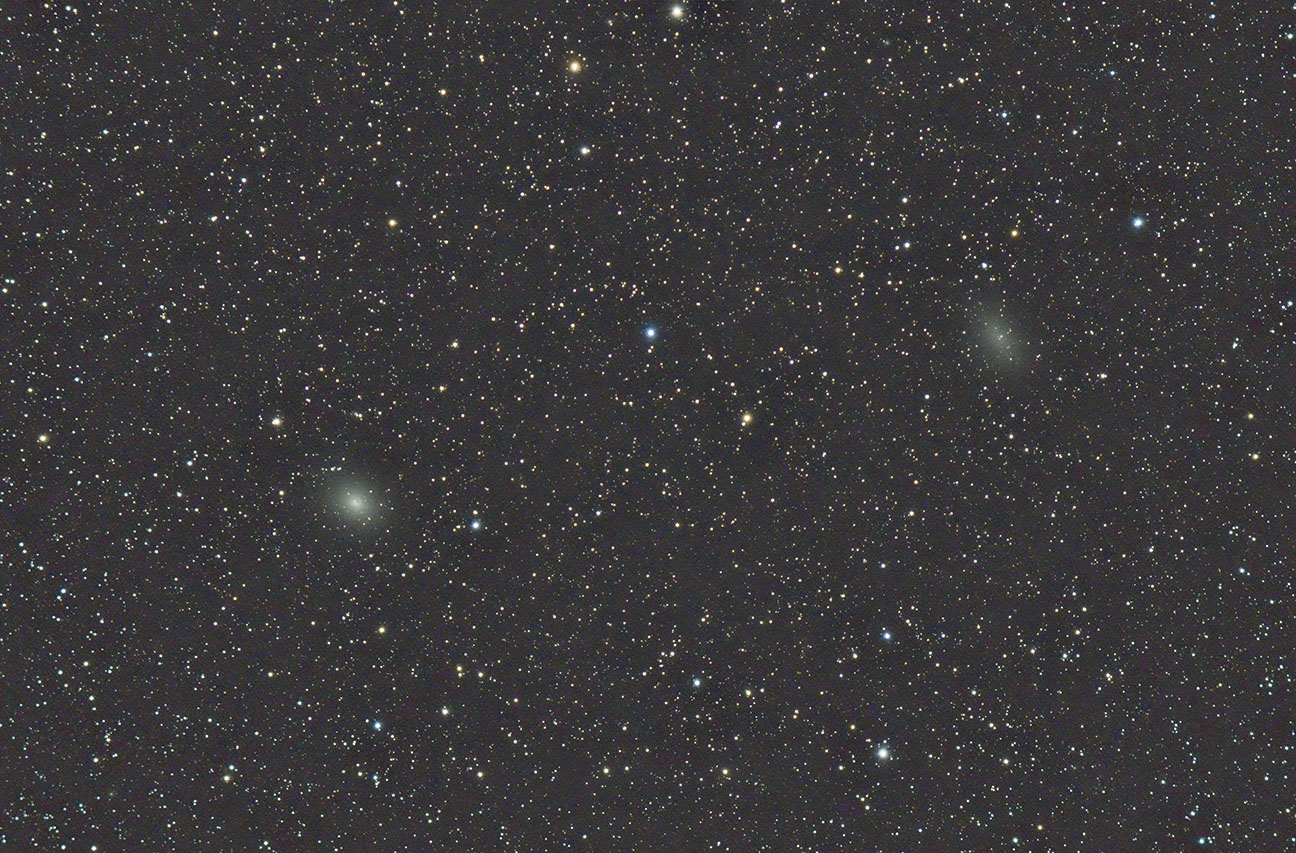
NGC147 (right) and NGC185 (left) are small satellite galaxies of M31
located in the constellation Cassiopeia.
They are about 7 degrees away from M31.
I used an Astronomic CLS filter on this shot to cut down some of the light pollution in this part
of the sky, but one of the side effects of the filter is that it will turn the white stars in
the image a teal blue.
Click on the image for a larger view in a new window.
Details:
Location: Front yard Cary, NC
Camera: ASI294mc-Pro
Exposure: 41 x 90s exposures gain 150
Filter: UV/IR, Astronomic CLS
Scope: TeleVue Genesis 4" f/5 refractor
Mount: iOptron GEM-45
Guider: Orion 60mm finder/guider
Capture software: ASIair
Guiding software: ASIair
Calibration frames: darks, flats, flat-dark
Processing software: Pixinsight, Photoshop CC, Topaz Denoise AI
Weather conditions: Cool and moist.
Notes: This image is cropped to about 2 by 1.25 degrees.
Back to Mark's Astrophotography Home
Tulip Nebula in Cygnus, Sept. 15, 2023
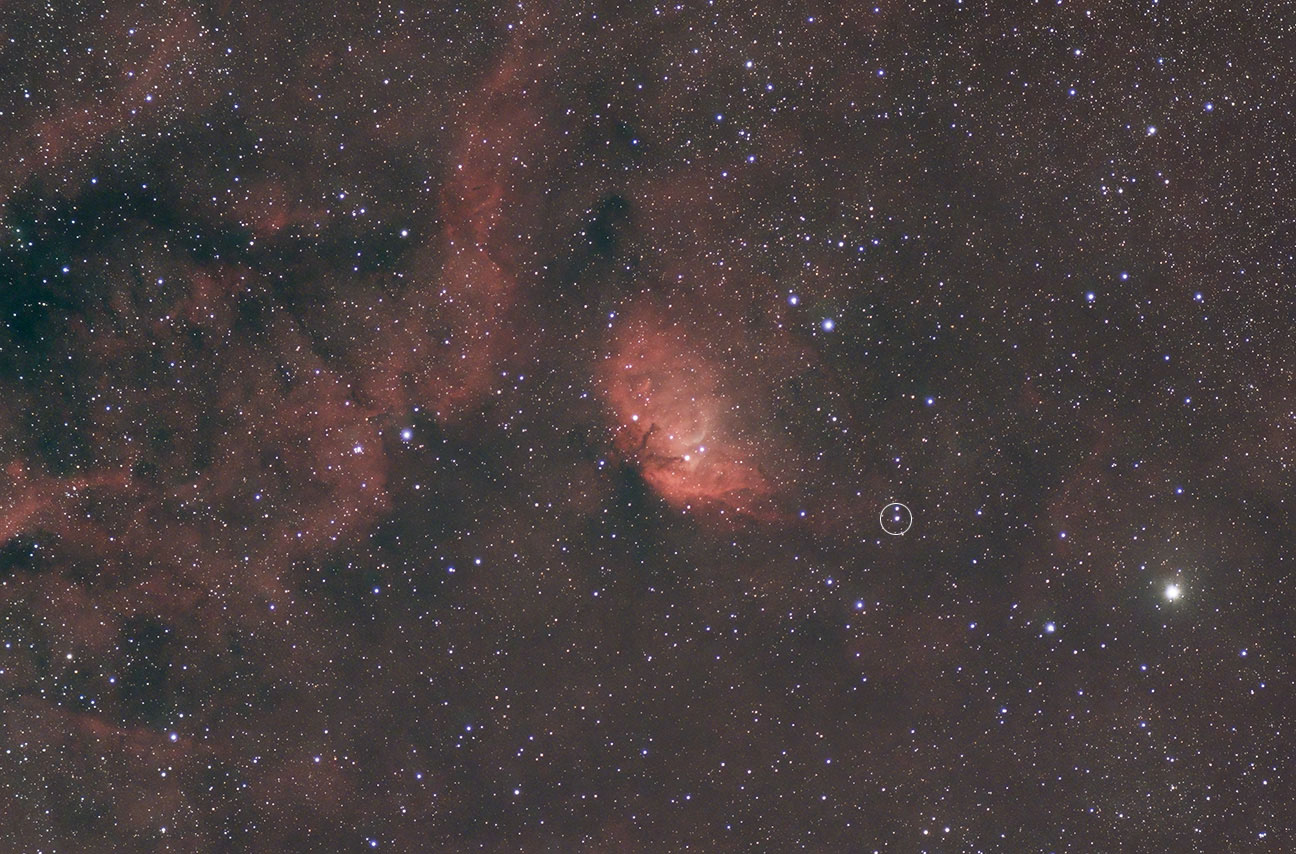
Tulip Nebula (SH 2-101) in Cygnus with lots of surrounding Ha nebulae.
This was a combination of broadband and narrowband data.
For the stars I took 7.5 minutes of unfiltered exposures and
for the nebulae I took 1.5 hours using the L-eNhance dual band filter.
I removed the stars from the narrowband image and combined it with the unfiltered image
to produce natural looking stars with the nebulae.
The star at the center of the circle lower right of the Tulip is called HDE 226868.
It is part of a binary system with Cygnus X-1.
Cygnus X-1 was the first accepted source to be a black hole back in 1971.
HDE 226868 is 7300 light years from Earth.
Click on the image for a larger view in a new window.
Details:
Location: Front yard Cary, NC
Camera: ASI294mc-Pro
Exposure: Stars 30 x 15s exposures gain 150 with uv/ir
Exposure: Nebula 30 x 180s exposures gain 150 with Optolong L-eNhance dual band filter
Filter: UV/IR and L-eNhance
Scope: TeleVue Genesis 4" f/5 refractor
Mount: iOptron GEM-45
Guider: Orion 60mm finder/guider
Capture software: ASIair
Guiding software: ASIair
Calibration frames: darks, flats, flat-dark
Processing software: Pixinsight, Photoshop CC, Topaz denoise
Weather conditions: Cool with temps in low 60s.
Notes: The image is cropped at the bottom and right side to center the Tulip.
This image was also part of the Club's Summer Triangle imaging challenge.
Back to Mark's Astrophotography Home
Barnard's E, Sept. 3, 2023
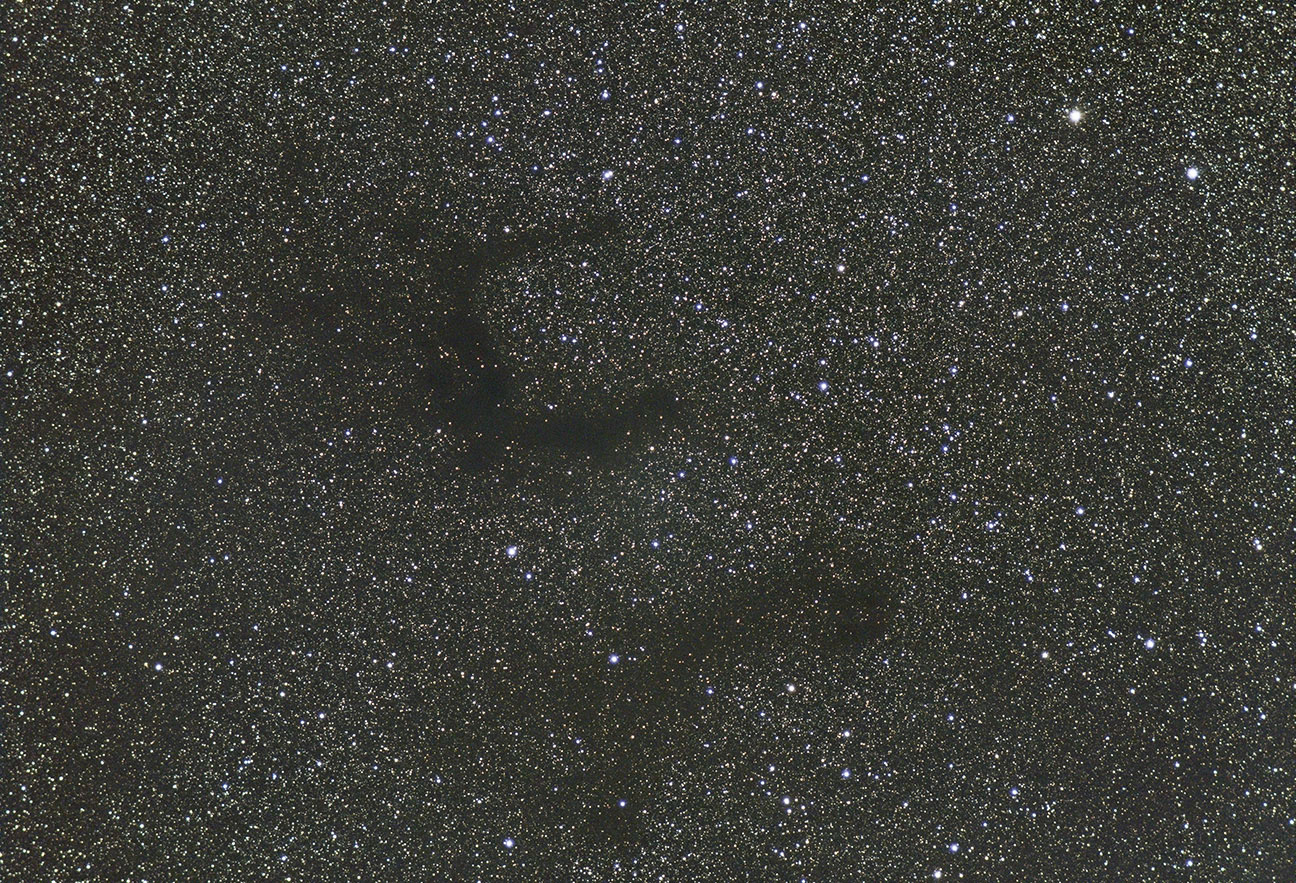
Barnard's "E" dark nebula (B 142) in Aquila.
This region of the Milky Way has a dense star field.
The FOV is 2 x 1.5 degrees and PixInsight counted just under 22,000 stars!
This photo was taken as part of the RAC Imaging Group's challenge for an object inside the
summer triangle.
Click on the image for a larger view in a new window.
Details:
Location: Front yard Cary, NC
Camera: ASI294mc-Pro
Exposure: 42 x 60s exposures gain 120
Filter: UV/IR
Scope: TeleVue Genesis 4" f/5 refractor
Mount: iOptron GEM-45
Guider: Orion 60mm finder/guider
Capture software: ASIair
Guiding software: ASIair
Calibration frames: darks, flats, flat-dark
Processing software: Pixinsight, Photoshop CC
Weather conditions: Pleasent temps in 60s.
Back to Mark's Astrophotography Home
NGC 7789 and WY Cas in Cassiopeia, Aug. 18, 2023
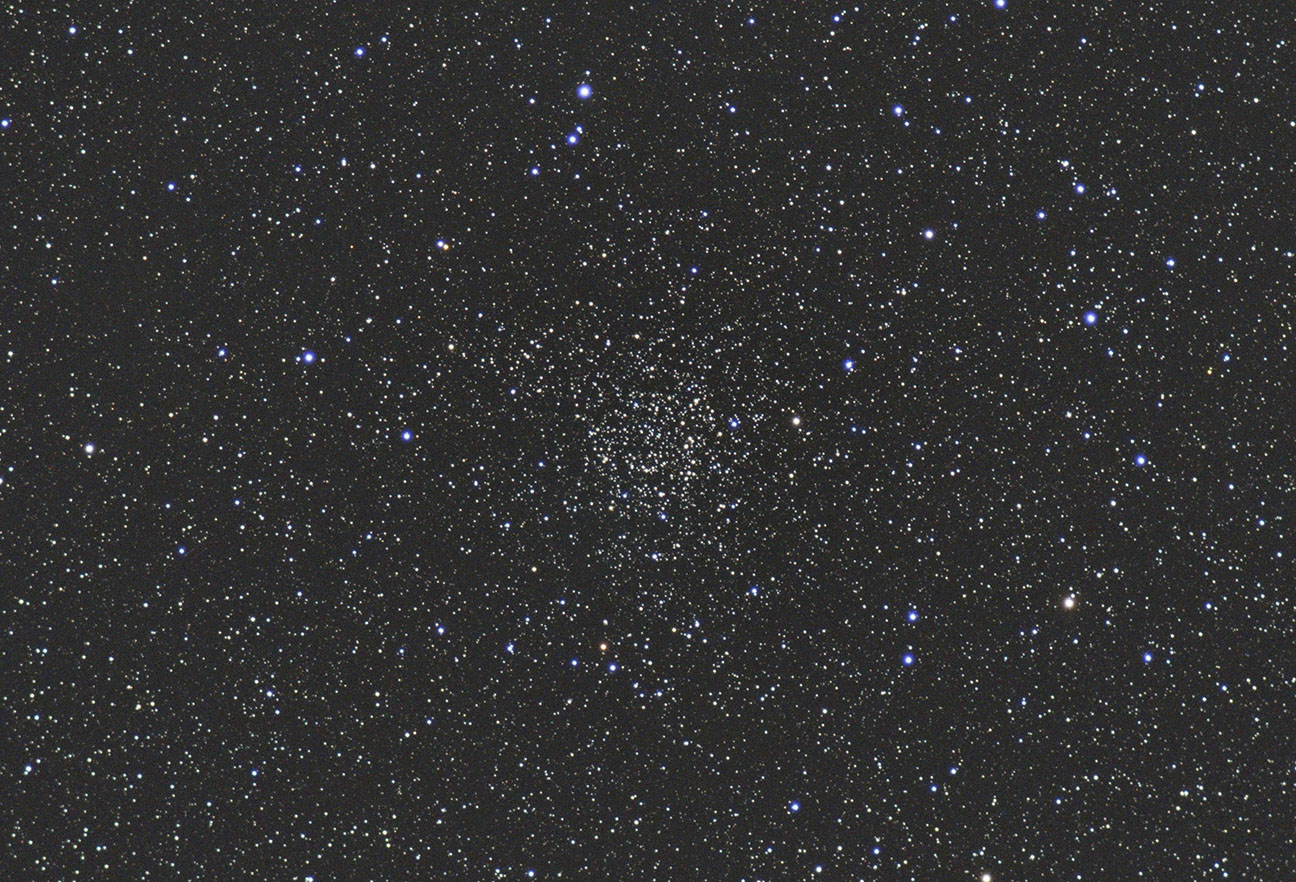
Open cluster NGC7789 and three variable stars in Cassiopeia.
NGC 7789 has always been one of my favorite open clusters.
In the eyepiece of my telescopes, it provides a beautiful rich view of tightly packed stars.
However, until a few weeks ago I had no idea that variable stars were very close by.
When I took the photo, I was hoping that the variable star WY Cas,
(orange colored star just south of the cluster) was
still bright.
The AAVSO says that the star varies from magnitude 7.5 to 16 over 481 days,
but the latest available light curve shows max brightness at around mag. 9.5 on 4/1/2021.
That means the next maximum should be around Nov. 19, 2023.
On my Aug. 2023 image,
the star was bright enough to show a distinct difference from my reference image I shot of the
cluster back in November 2010.
My estimate of the brightness of WY Cas from my recent image is around 9.5 or so.
I hope to get out and shoot the area again in November.
I was pleasently surprised to find two other variable stars in my photo.
You will also see them circled for ease of identification.
Currently, I don't have information on them.
Click on the image for a timelapse view showing the variable stars changing brightness.
Details:
Location: Front yard Cary, NC
Camera: ASI294mc-Pro
Exposure: 2023 version - 40 x 45s exposures (30 minutes total) gain 120
Exposure: 2010 version - 20 x 60s exposures (20 minutes total) Canon XTi ISO 800
Filter: UV/IR
Scope: 4" f/5 TeleVue Genesis refractor
Mount: iOptron GEM-45
Guider: Orion 60mm finder/guider
Capture software: ASIair
Guiding software: ASIair
Calibration frames: darks, flats, flat-dark
Processing software: Pixinsight, Photoshop CC
Weather conditions: Warm with temps in the mid to low 80s.
Back to Mark's Astrophotography Home
Comet 12P Pons-Brooks, July 27, 2023
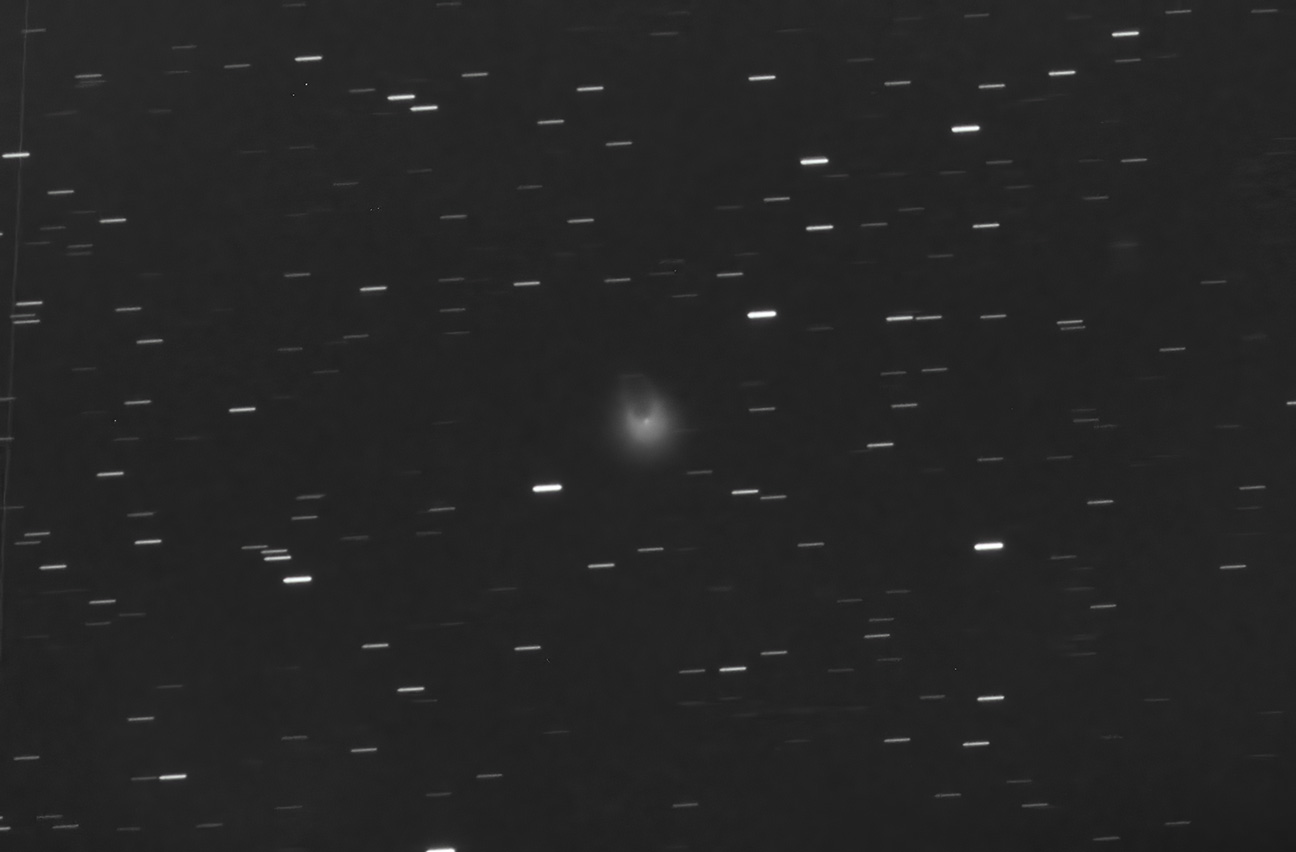
Comet 12P Pons-Brooks in Draco.
This is the strangest comet I have ever seen or photographed.
The top part of the comet is dark and no one understands why.
All of a sudden on July 20 it went into outburst increasing in brightness by 5 magnitudes.
It is currently somewhere around magnitude 11.6 and is out past the orbit of Mars.
This comet was discovered in 1812 and isn't due to come to perihelion until next year.
The mono image above is about a 50% crop of the original frame.
It is aligned on the comet and not the stars producing star streaks.
The field of view is approx. 20 x 15 arc minutes.
North is at the top.
Click on the image for a larger view in a new window.
Details:
Location: Front yard Cary, NC
Camera: ASI1600mm-Pro
Exposure: 44 x 45s exposures (33 minutes total) gain 139
Filter: UV/IR
Scope: Celestron Edge HD 800 SCT at f/7 (fl=1468)
Mount: iOptron GEM-45
Guider: Orion 60mm finder/guider
Capture software: ASIair
Guiding software: ASIair
Calibration frames: darks, flats, flat-dark
Processing software: Pixinsight, Photoshop CC
Weather conditions: Hot and muggy with temps around 85 with high humidity.
Back to Mark's Astrophotography Home
Comet C/2023 E1 (ATLAS), July 11, 2023
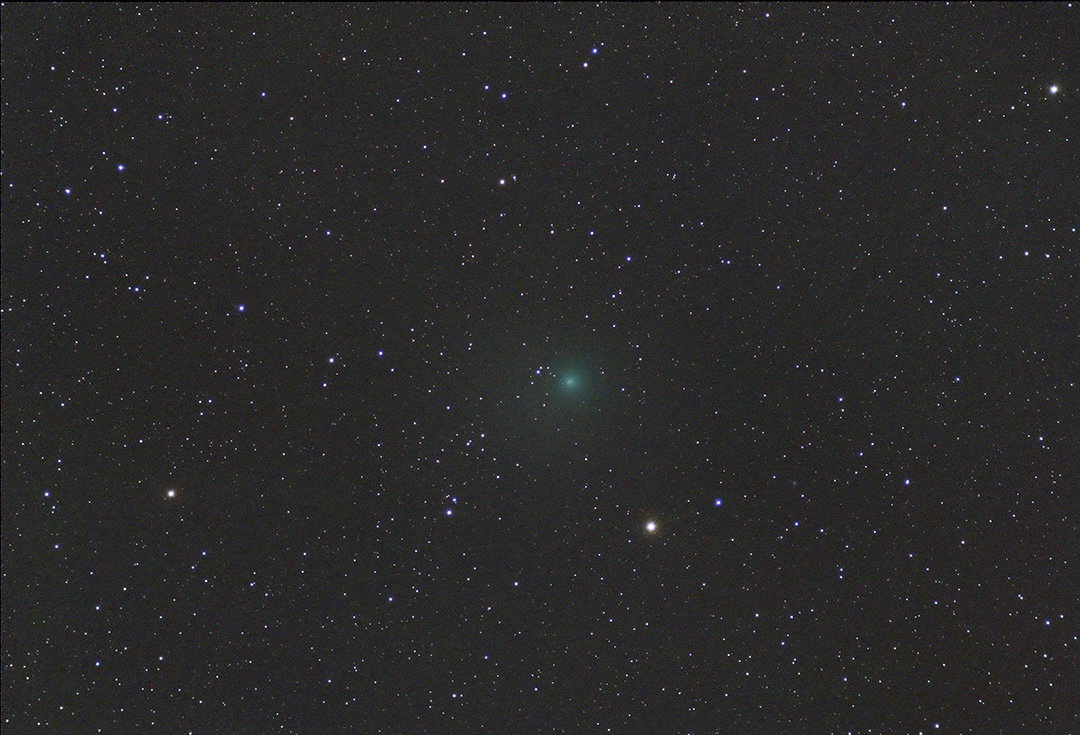
Comet C/2023 E1 (ATLAS).
Comet Atlas was lurking just a few degrees above Polaris tonight making it circumpolar.
Although no tail was visible here, longer photos from darker skies show a thin straight tail.
I only used 15 of my 37 exposures to freeze the motion of the comet.
Click on the image for a larger view in a new window.
Details:
Location: Front yard Cary, NC
Camera: ASI294mc-Pro
Exposure: 15 x 60s exposures gain 150
Filter: UV/IR
Scope: TeleVue Genesis 4" f/5 refractor
Mount: iOptron GEM-45
Guider: Orion 60mm finder/guider
Capture software: ASIair
Guiding software: ASIair
Calibration frames: darks, flats, flat-dark
Processing software: Pixinsight, Photoshop CC, Topaz Noise AI
Weather conditions: A mid-July cold front came through clearing the skies and lowering the humidity.
Temps were in the upper 60s.
Back to Mark's Astrophotography Home
Small Sagittarius Star Cloud, July 11, 2023
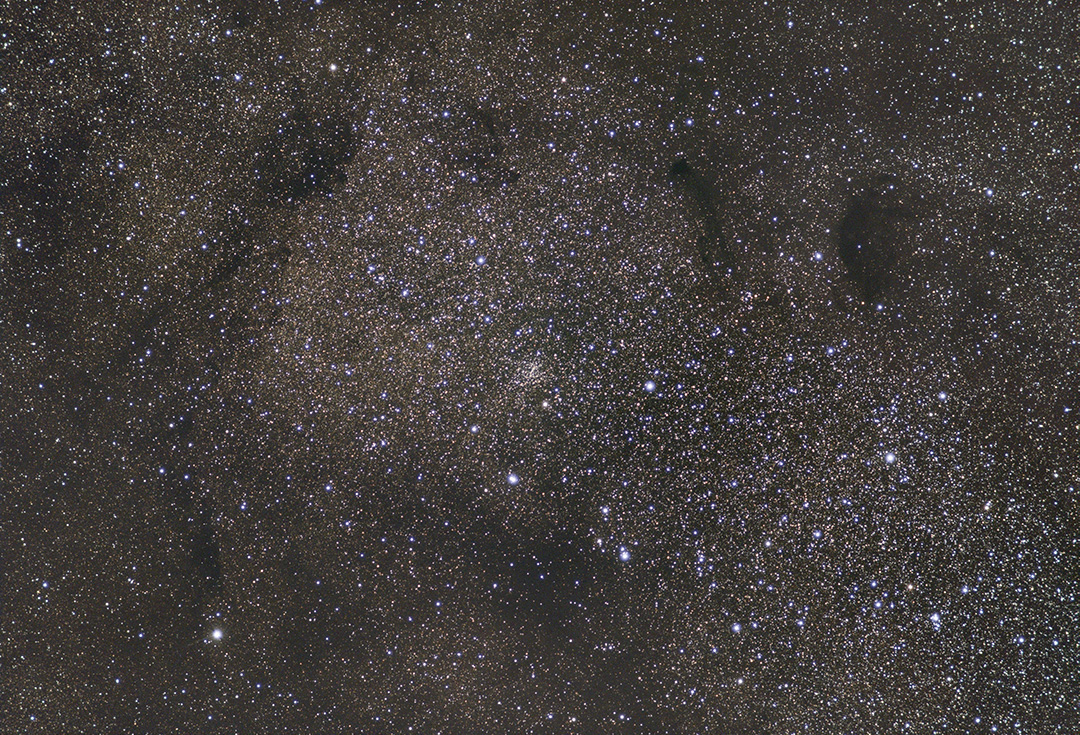
Most of the Small Sagittarius Sagittarius Star Cloud (M24).
Over the years, I have never photographed this one.
In this FOV, which spans 2 degrees by 1.5 degrees,
there are thousands of stars, several dark nebulae,
and a nice open cluster called NGC 6603 is at the center.
Objects like this make me want a smaller scope with a much wider FOV.
Click on the image for a larger view in a new window.
Details:
Location: Front yard Cary, NC
Camera: ASI294mc-Pro
Exposure: 36 x 60s exposures gain 150
Filter: UV/IR
Scope: TeleVue Genesis 4" f/5 refractor
Mount: iOptron GEM-45
Guider: Orion 60mm finder/guider
Capture software: ASIair
Guiding software: ASIair
Calibration frames: darks, flats, flat-dark
Processing software: Pixinsight, Photoshop CC
Weather conditions: A mid-July cold front came through clearing the skies and lowering the humidity.
Temps were in the upper 60s.
Back to Mark's Astrophotography Home
Link to Barnards Star animations, June 22, 2023
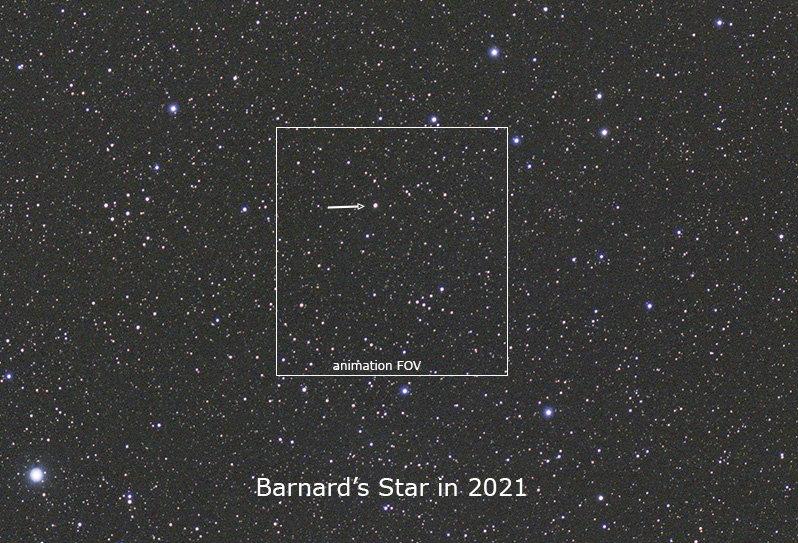
Click on the image above to go to the updated Barnard's Star section of my website. On that page is a new 40 year animation and a new 18 year animation.
Back to the top of the pageBack to Mark's Astrophotography Home
Supernova in M101, May 21, 2023
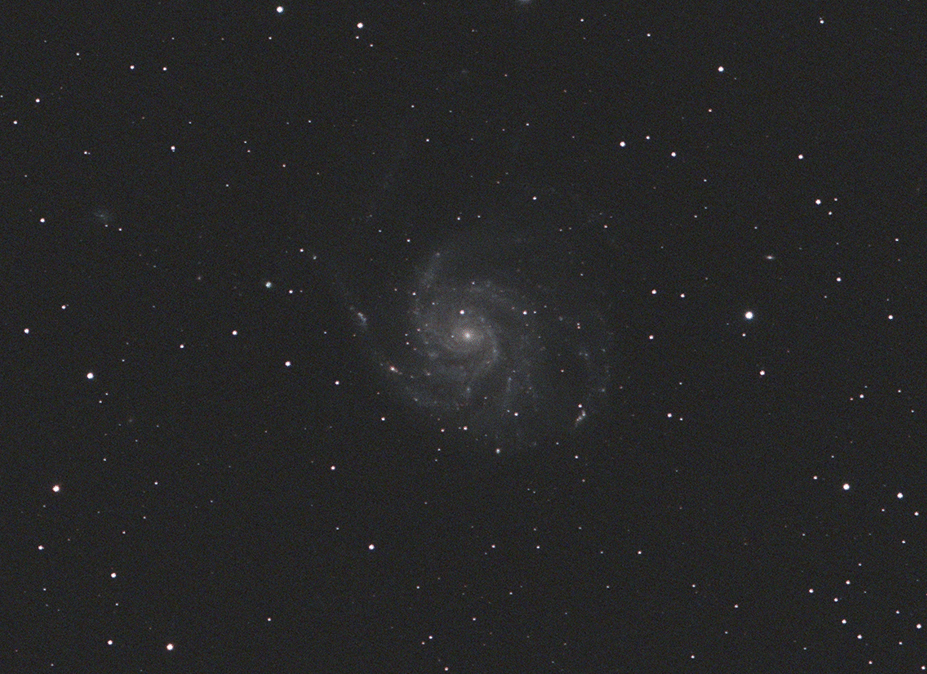
Supernova 2023ixf in spiral galaxy M101.
This animated gif shows SN 2023ixf brightening to magnitude 11.1.
The first image is from June 13, 2020.
The second image was taken May 21, 2023
Click on the image for a larger view in a new window.
Details:
Location: Front yard Cary, NC
Camera: ASI294mc-Pro
Exposure: 2020 image 15 x 2min, 2023 image 20 x 2min gain 150
Filter: UV/IR, 2020 image used a CLS also
Scope: TeleVue Genesis 4" f/5 refractor
Mount: iOptron GEM-45
Guider: Orion 60mm finder/guider
Capture software: ASIair
Guiding software: ASIair
Calibration frames: darks, flats, flat-dark
Processing software: Pixinsight, Photoshop CC
Weather conditions: Clear but hazy (probably smoke from Canadian forest fires.) temps in 60s
Notes: Animation created in Photoshop CC.
Back to Mark's Astrophotography Home
Satellites & M42, Jan. 26, 2022
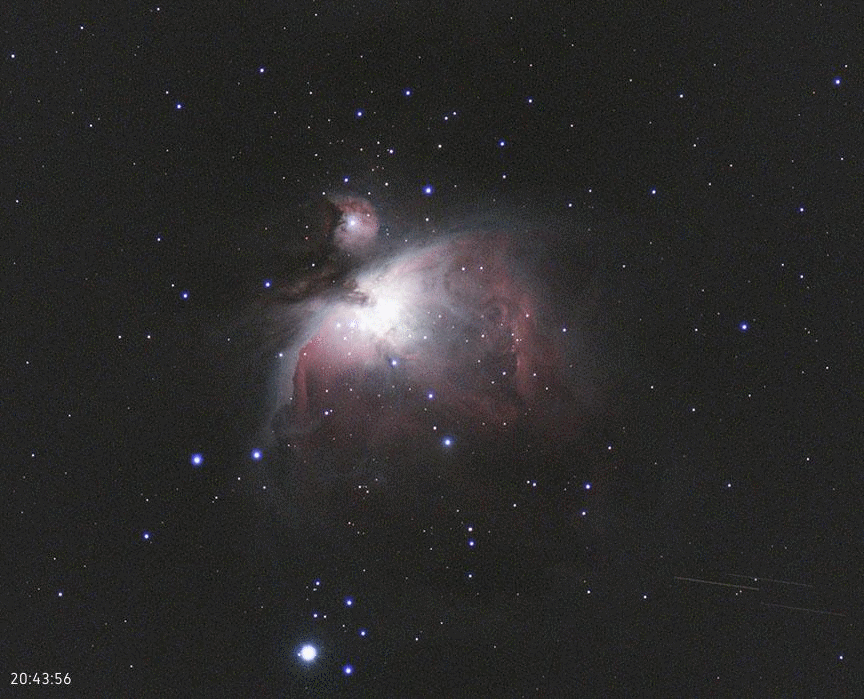
Geostationary satellites and the Orion Nebula animation.
The Orion Nebula (M42) was the target of the Jan. 2022 imaging challenge
for our imaging sub-group.
A year later, while reviewing the sub-frames taken back then, I took a look at
the raw frames to see if I caught any geostationary satellites passing through.
Although I had previously done an animation like this in monochrome with my old ST-402me,
I didn't have a nice color example so I decided to make one.
The gif animation shown is roughly 20 minutes of real time made from January's 30 x 30s frames.
I managed to catch 9 satellites in that short time.
If you think about it, the satellies are not moving in front of M42,
M42 is moving westward behind the satellites which are in a stationary orbit.
My mount was tracking M42 at the sidreal rate causing the apparent motion.
Click on the image for a larger view in a new window.
If you would like to see the final version of M42 without the satellites,
click here.
Details:
Location: Front yard Cary, NC
Camera: ASI294mc-Pro
Exposure: 30 x 30s (20 min. total) gain 150
Filter: UV/IR
Scope: TeleVue Genesis 4" f/5 refractor
Mount: iOptron GEM-45
Guider: Orion 60mm finder/guider
Capture software: APT
Guiding software: PHD2
Calibration frames: darks, flats, flat-dark
Processing software: Pixinsight, Photoshop CC, GIF animator
Weather conditions: Clear and cold with temps in the mid-20s.
Notes: PixInsight Image containers and process containers were used to process each
of the 30 frames individually. Each frame was cropped, ABE, SPCC, pixelmath stretch,
curves, and converted to jpg. GIF animatior created the gif you see here.
Back to Mark's Astrophotography Home
Spiral galaxy M90 in Virgo , Apr. 11, 2023
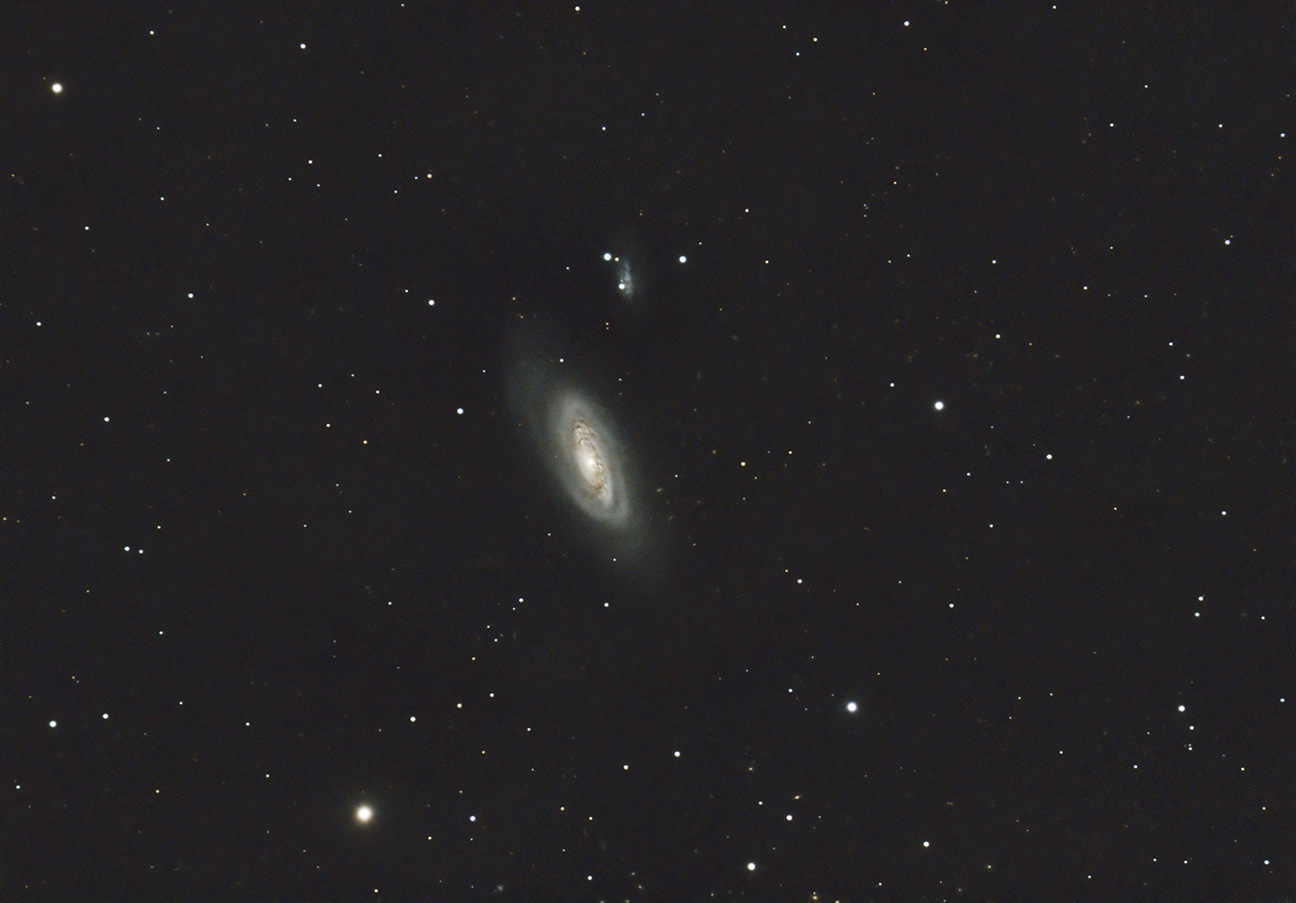
This is spiral galaxy M90 along with small galaxy IC 3583 just to its upper right in Virgo.
Many small galaxies can be seen near the lower end of the main galaxy.
Shot for 2 hours at a focal length of 1460mm with my C-8 SCT, this is a slightly cropped view of the
micro 4/3 sensor of my camera.
M90 is a fairly large galaxy at 9.5' x 4.5'.
I had to deal with some pretty wicked light pollution gradents during processing.
Click on the image for a larger view in a new window.
Details:
Location: Front yard Cary, NC
Camera: ASI294mc-Pro
Exposure: 60 x 2m (2 hrs. total) gain 150
Filter: UV/IR
Scope: Celestron EdgeHD 800 SCT with f/7 reducer
Mount: iOptron GEM-45
Guider: Orion 60mm finder/guider
Capture software: ZWO ASIair Plus
Guiding software: ZWO ASIair Plus
Calibration frames: darks, flats, flat-dark
Processing software: Pixinsight, Photoshop CC
Weather conditions: Clear and cool temp low 60s
Notes: The photo displayed is a slight crop of the original frame.
Simple processing in PixInsight: calibrate, stack, DBE, SPCC, BlurXterminator.
In Photoshop: resize, Topaz, and convert to JPG.
Back to Mark's Astrophotography Home
Ceres moving toward M100, Mar. 24, 2023
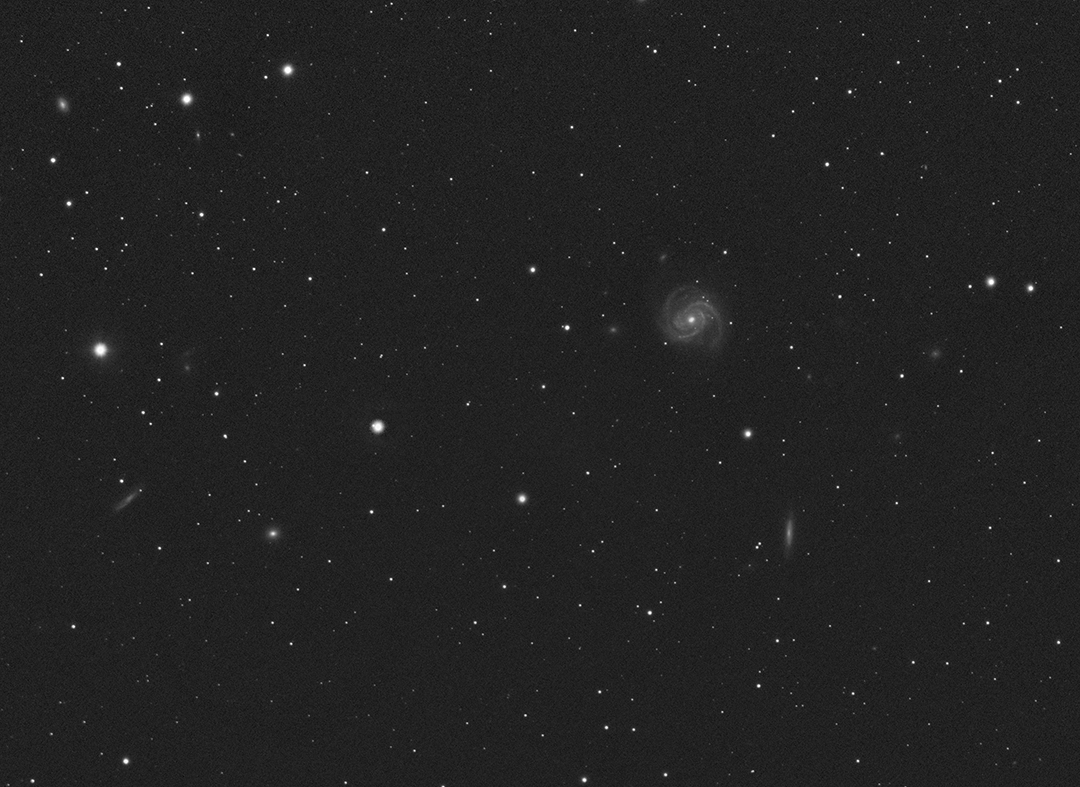
This is dwarf planet Ceres moving towards a conjunction with the large spiral galaxy M100
in Coma Berenices. There are many other fainter galaxies in the photo.
In this animated gif, Ceres (7th magnitude) is near the left center moving back and forth.
I took a set of 30 x 90 second exposures of this area to make the background image,
but due to its motion over 45 minutes, Ceres was elongated.
In Photoshop, I overlaid the first and last single exposures over the Ceres streak
of the composite and made the animated GIF.
This photo was supposed to happen on the evening of Mar. 26, 2023 when Ceres was directly over M100,
but clouds prevented that photo.
Instead I had to take the photo two days early.
I had planned to use my Celestron EdgeHD 800 and color camera,
but I already had my Genesis out with the ASI1600mm mono camera attached working on another project.
Click on the image for a larger view in a new window.
Details:
Location: Front yard Cary, NC
Camera: ASI1600mm-Pro
Exposure: 30 x 90s gain 139
Filter: UV/IR
Scope: Televue Genesis 4" f/5 refractor
Mount: iOptron GEM-45
Guider: Orion 60mm finder/guider
Capture software: ZWO ASIair Plus
Guiding software: ZWO ASIair Plus
Calibration frames: darks, flats, flat-dark
Processing software: Pixinsight, Photoshop CC, GradientXTerminator
Weather conditions: Warm with some high clouds
Notes: The photo displayed is a crop of the original frame.
The first photo was started at 11:32 pm and the last exposure started at 00:20 am.
Simple processing in PixInsight: calibration, stack, DBE, SPCC, noise reduction.
In Photoshop: sharpen, resize, convert to JPG.
Back to Mark's Astrophotography Home
IC 410 including the Tadpoles, Feb. 13, 2023
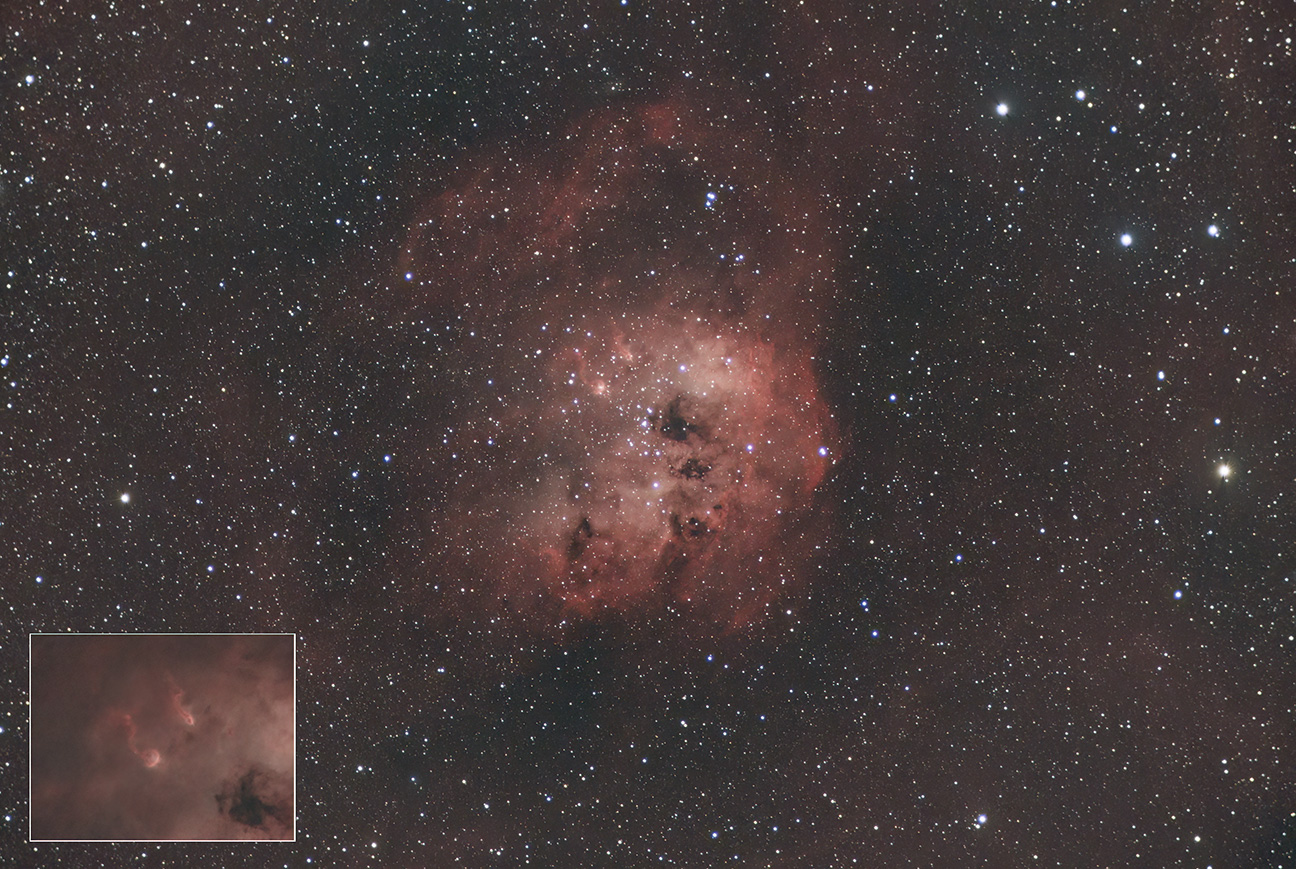
The Tadpoles nebula inside IC 410 in Auriga.
I captured this image of the Tadpoles and surrounding nebula on the same evening
as my previous shot of Comet C/2020 E3 ZTF.
The tadpoles are in the upper center of the large nebula.
Also shown as an inset at the bottom left corner are the tadpoles slightly
enlarged and shown without stars.
The image shown is in near true color and is a combination of narrow band data and broadband data.
60 x 120 second exposures were captured with an Optolong L-eNhance filter and then
30 x 15 second exposures were taken with just a UV/IR filter.
The stars were extracted from the narrowband data and then the starkess image was
combined with the broadband data to produce stars with natural colors.
The image was slightly cropped and had noise reduction run on it.
The image is approx. 2 degrees wide by 1.5 degrees tall with north at the top.
NGC 1893 is the small open cluster of stars at the center of IC 410.
Click on the image for a larger view in a new window.
Details:
Location: Front yard Cary, NC
Camera: ASI294mc-Pro
Exposure: 60 x 120s nb and 30 x 15s bb gain 150
Filter: Optolong L-eNhance for narrowband (nb) and UV/IR for broadband (bb)
Scope: Televue Genesis 4" f/5 refractor
Mount: iOptron GEM-45
Guider: Orion 60mm finder/guider
Capture software: ZWO ASIair Plus
Guiding software: ZWO ASIair Plus
Calibration frames: darks, flats, flat-dark
Processing software: Pixinsight, Photoshop CC Topaz denoise
Weather conditions: Clear and cold
Notes: The photo displayed is a crop of the original frame.
Back to Mark's Astrophotography Home
Comet C/2022 E3 ZTF, Feb. 13, 2023
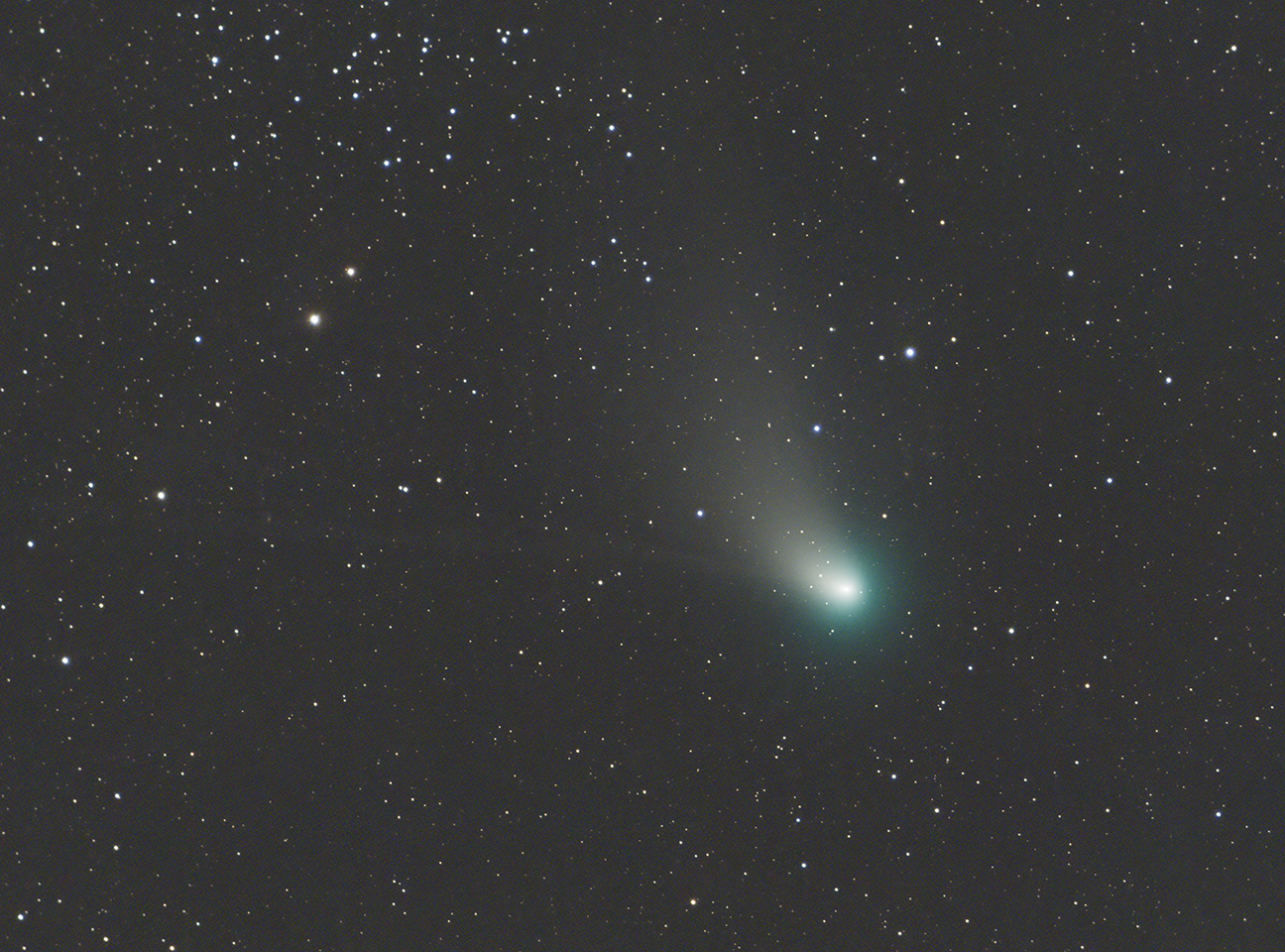
Comet C/2022 E3 ZTF in Taurus and now showing a more normal comet appearance.
Unlike the previous photo from 3 weeks earlier (below) the anti-tail is gone
and just a thin faint ion tail and the dust tail remain.
The ion tail goes from the left side of the nucleus to the edge of the frame.
Processing this version was more difficult than the last time because the comet brightness has faded.
Part of open cluster NGC1647 is at the upper left edge.
Click on the image for a larger view in a new window.
Details:
Location: Front yard Cary, NC
Camera: ASI294mc-Pro
Exposure: 60 x 30s gain 150
Filter: UV/IR
Scope: Televue Genesis 4" f/5 refractor
Mount: iOptron GEM-45
Guider: Orion 60mm finder/guider
Capture software: ZWO ASIair Plus
Guiding software: ZWO ASIair Plus
Calibration frames: darks, flats, flat-dark
Processing software: Pixinsight, Photoshop CC Topaz denoise
Weather conditions: Clear and cold
Notes: The photo displayed is a crop of the original frame.
Pixinsight's comet align with subtraction was used to produce a starless combined comet image.
Back to Mark's Astrophotography Home
Comet C/2022 E3 ZTF, Jan. 24, 2023
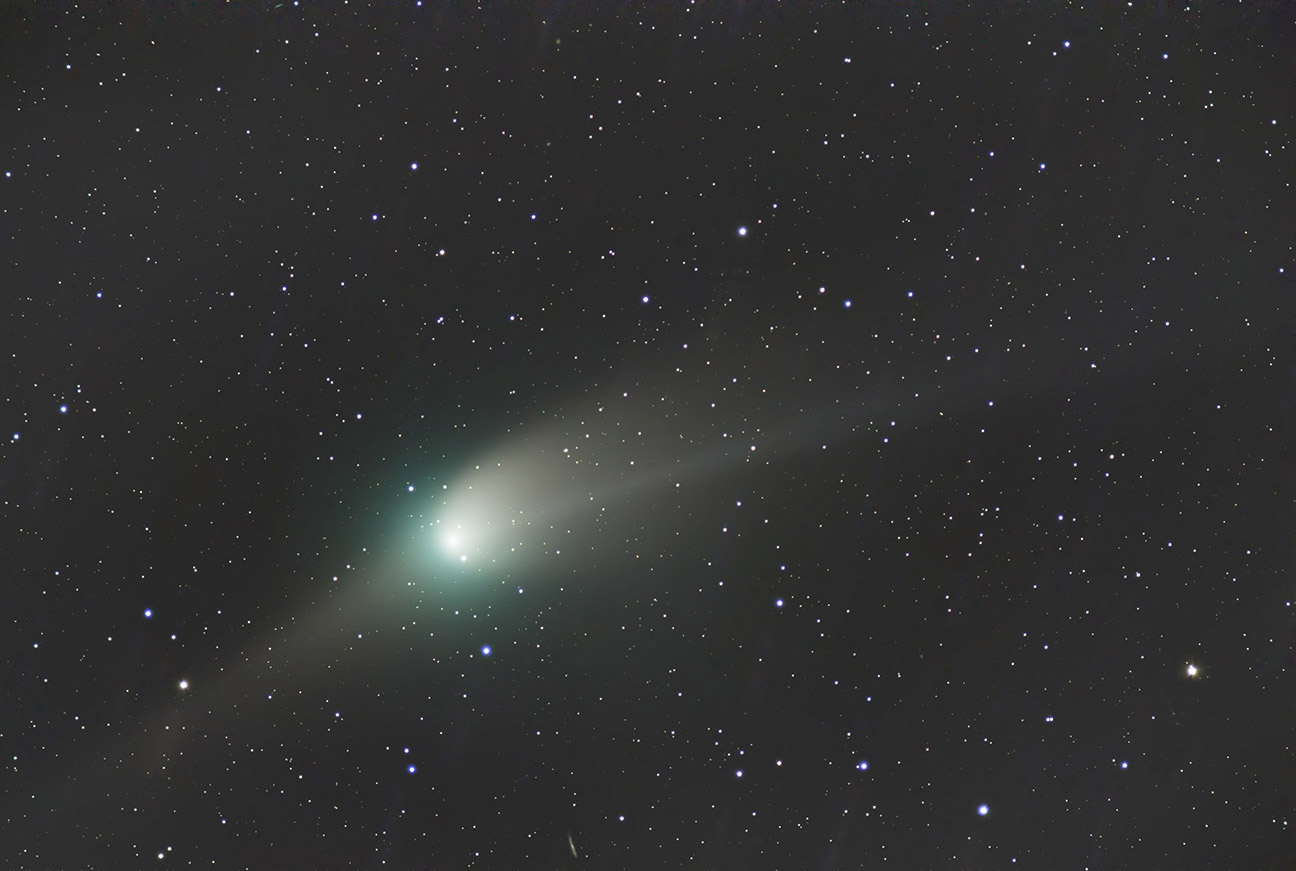
Comet C/2022 E3 ZTF was zooming through the constellation Draco Tuesday morning between 4:22 and
5:32. 56 x 60 second exposures were combined together in two sets to produce this image.
One set of images was aligned to the stars and one set was aligned to the comet and the two
sets were combined together.
There are three tails visible in this photo.
The anti-tail points to the lower left.
The ion tail is the faint thin tail pointing upper right to the edge of the frame.
The broad dust tail also points to the upper right.
Note the small edge on spiral galaxy NGC 5894 (mag. 13.0) below the comet head on the edge of the frame.
The field of view of the photo is approx. 2 x 1.4 degrees. The comet is pretty big.
North is at the top.
Click on the image for a larger view in a new window.
Details:
Location: Front yard Cary, NC
Camera: ASI294mc-Pro
Exposure: 56 x 60s gain 150
Filter: UV/IR
Scope: Televue Genesis 4" f/5 refractor
Mount: iOptron GEM-45
Guider: Orion 60mm finder/guider
Capture software: ZWO ASIair Plus
Guiding software: ZWO ASIair Plus
Calibration frames: darks, flats, flat-dark
Processing software: Pixinsight, Photoshop CC
Weather conditions: Very clear and cold temp about 31F
Notes: The photo displayed is a slight crop of the original frame.
Back to Mark's Astrophotography Home
Comet C/2022 E3 ZTF, Jan. 24, 2023
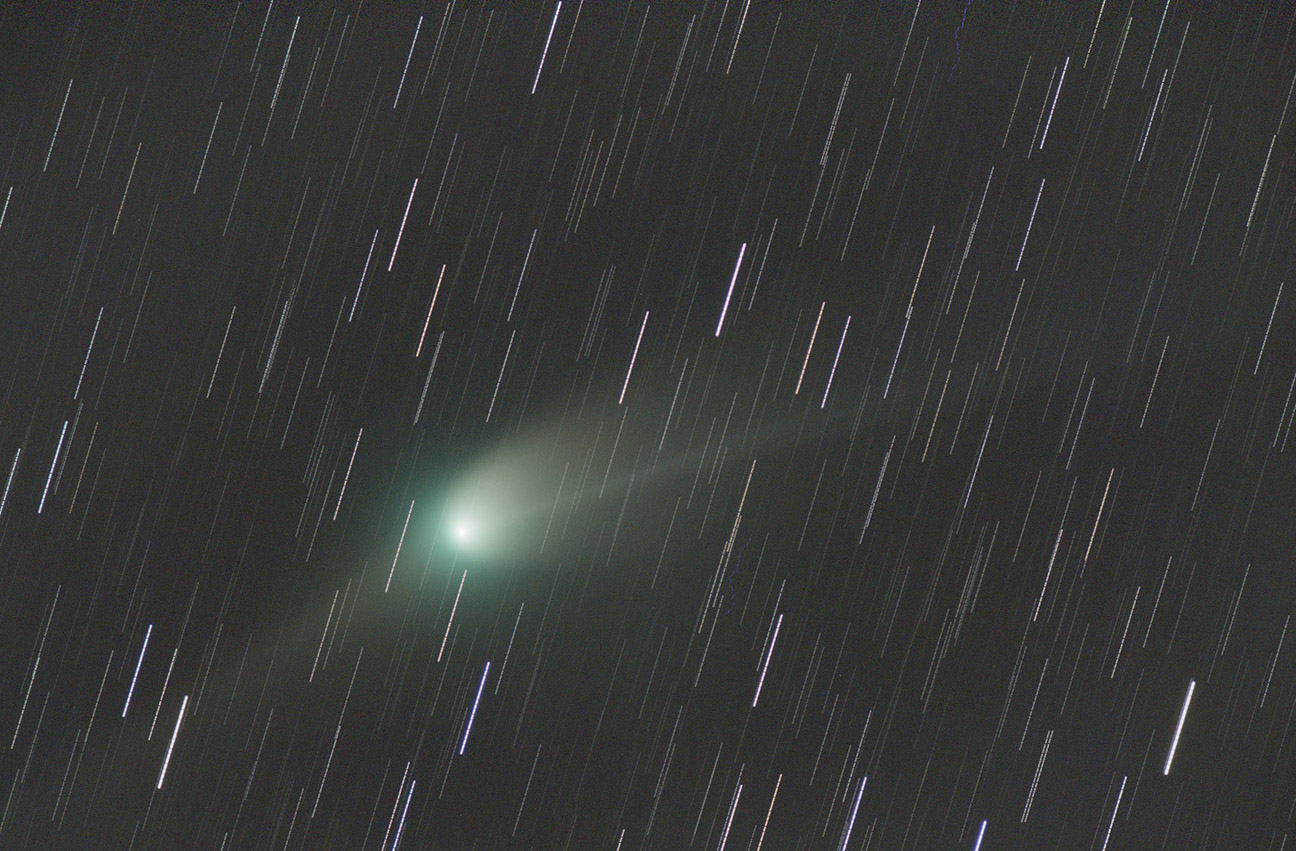
Comet C/2022 E3 ZTF using the same data as the previous photo,
but this time the stars were allowed to trail showing the movement
of the comet over nearly an hour.
Click on the image for a larger view in a new window.
Details:
Location: Front yard Cary, NC
Camera: ASI294mc-Pro
Exposure: 55 x 60s gain 150
Filter: UV/IR
Scope: Televue Genesis 4" f/5 refractor
Mount: iOptron GEM-45
Guider: Orion 60mm finder/guider
Capture software: ZWO ASIair Plus
Guiding software: ZWO ASIair Plus
Calibration frames: darks, flats, flat-dark
Processing software: Pixinsight, Photoshop CC
Weather conditions: Very clear and cold temp about 31F
Notes: The photo displayed is a slight crop of the original frame.
Back to Mark's Astrophotography Home